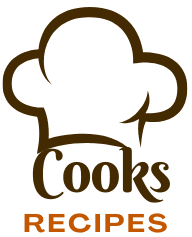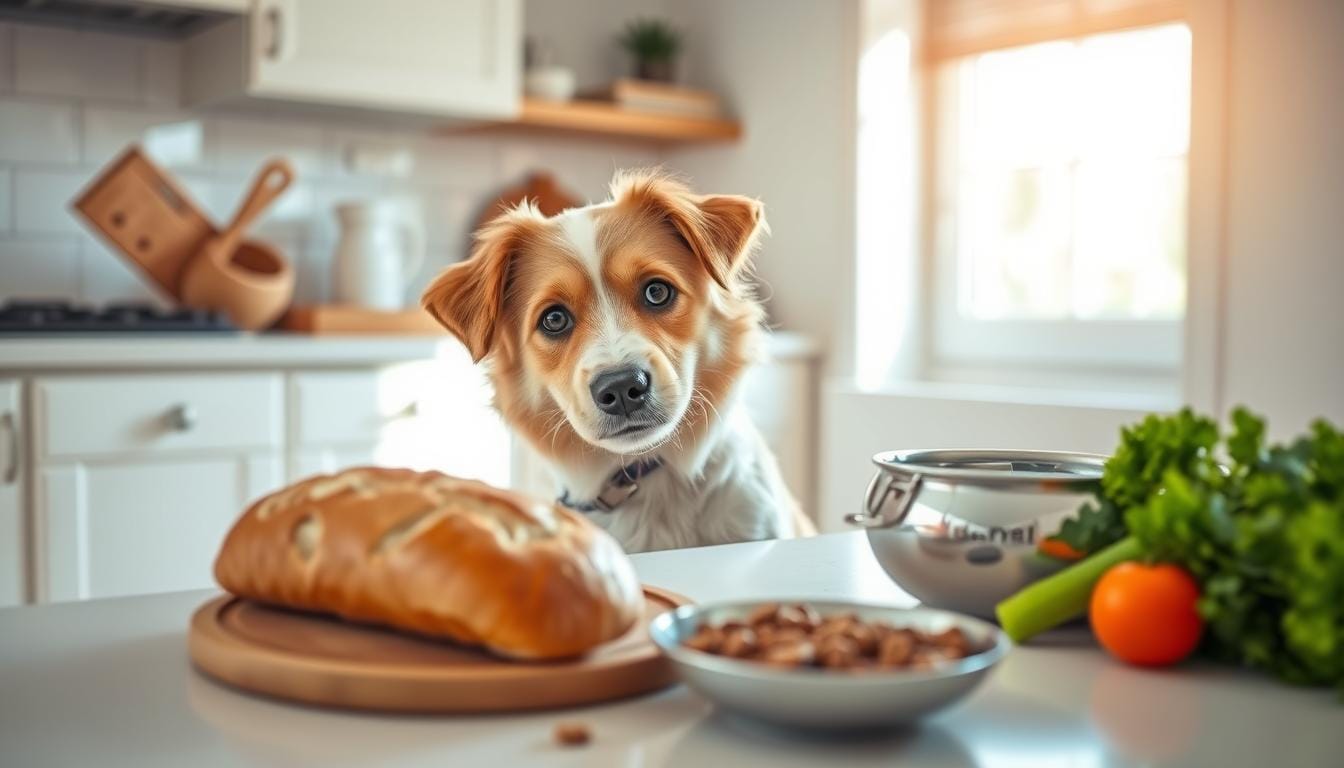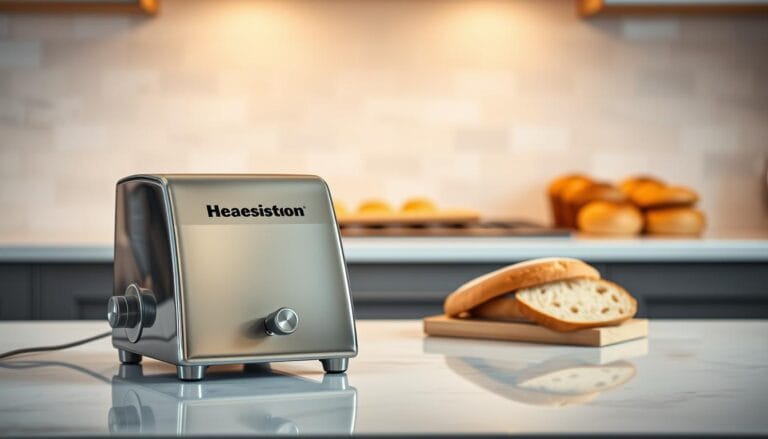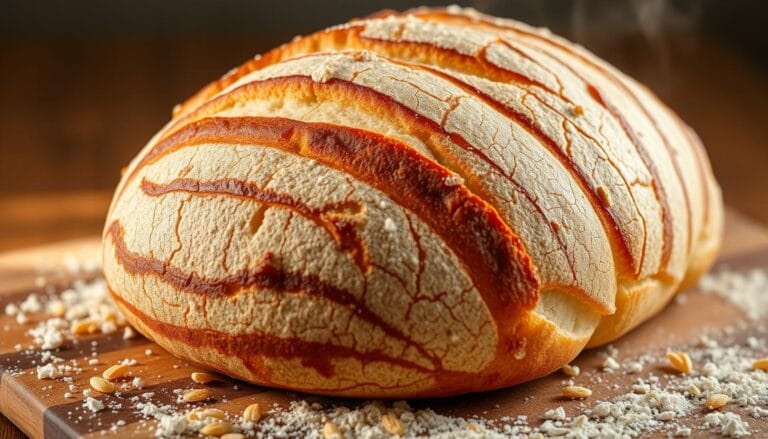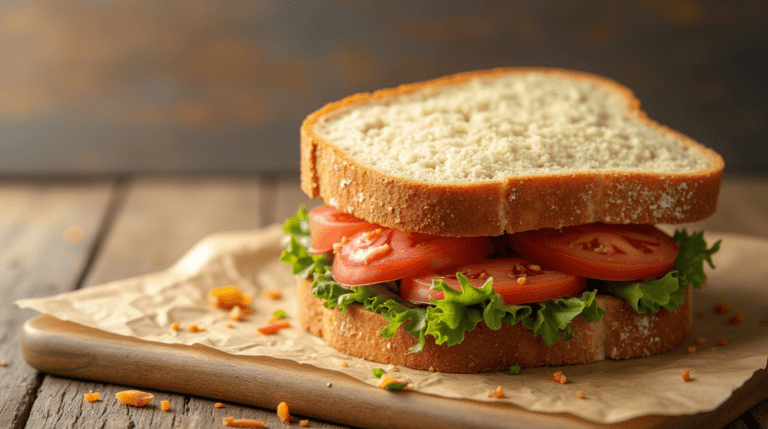Can Dogs Eat Garlic Bread? Best Surprising Facts
Every pet owner has seen their furry friend look up with puppy eyes, wanting a bite of garlic bread. But before giving in, ask yourself: is garlic bread safe for dogs?
The truth about dog garlic bread safety is more complex than you think. Veterinary experts say that what looks like a harmless treat can actually harm your pet. Garlic bread has ingredients that are toxic to dogs, making it a bad choice for them.
It’s important to know the risks for pet owners. Dogs process food differently than humans, and some ingredients that are safe for us can be harmful to them. Garlic, a key part of garlic bread, is especially dangerous for dogs because it belongs to the allium family.
In this guide, we’ll look at the surprising facts about garlic bread and its effects on dogs. You’ll learn about toxic ingredients and symptoms to watch for. This knowledge will help you keep your dog safe and healthy.
Table of Contents
Understanding the Dangers of Garlic Bread for Dogs
Garlic bread is not safe for dogs. Dogs can’t handle certain foods like humans do. Garlic bread can harm your dog’s health.
Garlic has compounds called organosulfides. These are very bad for dogs and can damage their red blood cells. It’s important for pet owners to know this.
Key Ingredients That Make Garlic Bread Harmful
- Garlic: Highly toxic to dogs, even in small amounts
- Butter: High fat content can trigger pancreatitis
- Bread: Potential wheat allergies and digestive issues
- Seasonings: Additional ingredients may cause further complications
Nutritional Components and Their Effects
Garlic bread is not good for dogs. The garlic can cause hemolytic anemia. This is when red blood cells get destroyed too fast.
| Ingredient | Potential Risk | Severity |
|---|---|---|
| Garlic | Red Blood Cell Damage | High |
| Butter | Pancreatitis | Moderate |
| Wheat | Allergic Reactions | Low to Moderate |
Risk Factors for Different Dog Breeds
Dogs react differently to garlic bread. Smaller dogs and those with health issues are more at risk. Dog allergies to garlic can also vary.
Always consult your veterinarian about specific dietary concerns for your dog’s unique health profile.
If you want dog-friendly bread recipes or pet safe garlic substitutes, get advice from a vet. This ensures your dog stays healthy.
The Toxic Effects of Garlic on Canine Health
Garlic is harmful to dogs and owners need to know this. The Allium family, which includes garlic, is dangerous for dogs. Garlic can damage a dog’s red blood cells, leading to hemolytic anemia.
“Even small amounts of garlic can be dangerous for your furry friend’s health”
The harm garlic causes dogs depends on the amount and the dog’s size. Here are important things to know about garlic toxicity:
- Garlic is 5 times more toxic to dogs than other Allium family members
- Symptoms can appear 24 hours to a week after ingestion
- Oxidative damage to red blood cells is the primary concern
| Dog Weight | Toxic Garlic Threshold | Potential Symptoms |
|---|---|---|
| 10 lbs | 67-135 grams | Weakness, lethargy |
| 30 lbs | 204-408 grams | Pale gums, rapid breathing |
| 50 lbs | 330-660 grams | Dark urine, anemia |
Canine dietary restrictions are crucial when it comes to preventing garlic toxicity. Veterinary treatment may include charcoal administration, IV fluids, or in severe cases, blood transfusions.
Spotting garlic poisoning early can save a dog’s life. Look for signs like abdominal pain, blood in urine, diarrhea, vomiting, and extreme tiredness. Always call your vet right away if you think your dog ate garlic.
Common Ingredients in Garlic Bread and Their Impact on Dogs
It’s important to know what’s in garlic bread to keep dogs safe. The mix of ingredients can be harmful to dogs. Many parts of garlic bread can lead to serious health problems for dogs.
Dairy Dangers: Butter and Cheese
Dogs often have trouble with dairy because they can’t digest lactose. Butter and cheese in garlic bread can upset their stomachs. Up to 50% of dogs have big problems with dairy. The fat in these foods can also cause pancreatitis, a serious condition.
| Dairy Component | Potential Dog Health Risks |
|---|---|
| Butter | Digestive upset, pancreatitis |
| Cheese | Weight gain, lactose intolerance |
Herbs and Seasonings: Hidden Threats
Herbs in garlic bread can be very dangerous for dogs. Garlic is a big worry because it has a toxic compound. Even a little bit can cause:
- Digestive distress
- Potential blood cell damage
- Risk of hemolytic anemia
Bread Types and Additional Hazards
Not all breads are safe for dogs. Some have raisins or artificial sweeteners that are bad for pets. It’s key to check the ingredients to keep your dog safe.
“Prevention is always better than cure when it comes to your dog’s dietary health.” – Veterinary Nutrition Expert
Keeping dogs safe means avoiding bad human foods. Always talk to your vet about safe bread and garlic substitutes for dogs.
Can Dogs Eat Garlic Bread: The Definitive Answer
Dogs should not eat garlic bread. Veterinary experts say it’s not safe for them. It can harm your furry friend’s health.
Garlic has a compound called thiosulfate. It’s toxic to dogs and can damage their red blood cells. The US National Library of Medicine warns that even a little garlic can be harmful. Dogs can get sick from 15g to 30g of garlic per kilogram of their body weight.
“Prevention is always better than cure when it comes to dog nutrition.” – Veterinary Nutrition Specialist
- Garlic bread contains multiple dangerous ingredients for dogs
- Potential health risks include immediate and long-term complications
- Even small amounts can trigger severe reactions
Dog garlic bread safety is not negotiable. The mix of garlic, butter, and bread is dangerous. Symptoms of garlic poisoning include:
- Abdominal pain
- Foul breath
- Blood in urine
- Diarrhea
- Vomiting
- Difficulty breathing
Severe cases can cause collapse, rapid heart rate, and seizures. The risk depends on your dog’s size, breed, and sensitivity.
| Dog Size | Garlic Toxicity Risk |
|---|---|
| Small Breeds | High Sensitivity |
| Medium Breeds | Moderate Risk |
| Large Breeds | Lower But Still Dangerous |
Always consult your veterinarian if your dog accidentally consumes garlic bread and monitor for any adverse reactions.
Signs and Symptoms of Garlic Poisoning in Dogs
It’s important for pet owners to know about garlic toxicity in dogs. Dogs should not eat garlic because it can be harmful. Even small amounts can cause serious health problems.
Immediate Reactions to Garlic Consumption
Dogs may show signs of poisoning right after eating garlic. These signs include:
- Vomiting and diarrhea
- Abdominal pain and discomfort
- Extreme lethargy and weakness
- Pale or yellowish gums
- Rapid breathing
“Recognizing these symptoms quickly can be life-saving for your furry friend.” – Veterinary Nutrition Expert
Long-term Health Consequences
Dogs can develop serious health issues from garlic allergies. These can include:
- Hemolytic anemia
- Organ damage
- Weakened immune system
- Reduced red blood cell function
The effects of garlic can show up 24 hours to a week after eating it. It’s crucial to watch your dog’s health and get vet help fast if you think they ate garlic.
Don’t give garlic to dogs. It’s not safe for them. Always talk to your vet about what food is good for your dog.
Safe Alternatives to Garlic Bread for Dogs
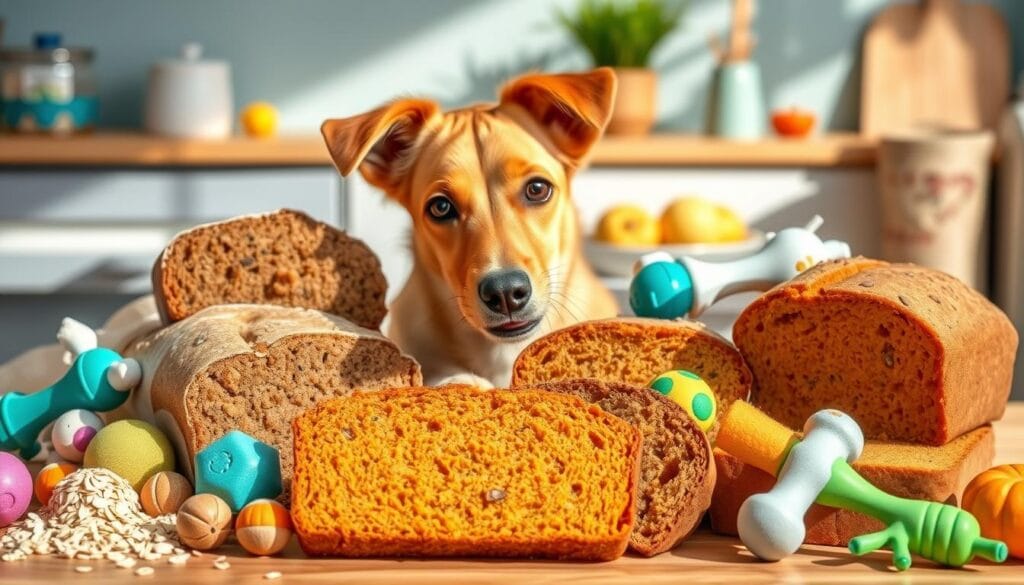
Keeping your furry friend healthy means finding tasty, safe alternatives to garlic bread. Dog-friendly bread recipes can provide delightful treats without risking your pet’s well-being. Your canine companion deserves nutritious options that satisfy their taste buds while supporting their overall health.
When searching for pet safe garlic substitutes, consider these nutritious alternatives:
- Homemade pumpkin bread (without spices)
- Plain whole wheat crackers
- Unsweetened cornbread
- Plain rice cakes
- Vegetable-based dog biscuits
Dogs require carefully balanced nutrition. Veterinarians recommend that treats should comprise only 10% of a dog’s diet. When preparing dog-friendly bread recipes, focus on simple ingredients and avoid harmful additives.
| Safe Ingredient | Nutritional Benefit | Serving Size |
|---|---|---|
| Pumpkin | Fiber, Vitamin A | 1-2 tablespoons |
| Sweet Potato | Vitamins, Minerals | Small slice |
| Carrot | Low-calorie Snack | 1-2 small pieces |
Remember: Moderation is key when introducing any new food to your dog’s diet.
Pro tip: Always consult with your veterinarian before making significant changes to your dog’s nutrition plan.
By choosing carefully crafted, dog-friendly alternatives, you can ensure your pet enjoys delicious treats without compromising their health. Pet safe garlic substitutes are abundant and can make treat time both enjoyable and nutritious.
Understanding Garlic Toxicity Levels in Dogs
Dog owners need to watch out for garlic toxicity. Knowing the risks of garlic is key to keeping your pet safe and healthy.
Garlic is very harmful to dogs. Studies show it’s 5 times more toxic than onions and chives. The danger depends on the dog’s weight and how much garlic they eat.
Measuring Toxic Doses
The danger of garlic changes with a dog’s size. Here’s a look at the risks:
- 6 lbs dog: 40–80 grams (8–16 garlic cloves)
- 10 lbs dog: 67–135 grams (13–27 garlic cloves)
- 20 lbs dog: 135–270 grams (27–54 garlic cloves)
Risk Factors by Dog Size
Smaller dogs are more at risk. Even a small amount can harm them more than bigger dogs.
| Dog Weight | Toxic Range (grams) | Approximate Cloves |
|---|---|---|
| 30 lbs | 204–408 | 40–81 |
| 50 lbs | 330–660 | 66–132 |
| 80 lbs | 543–1,086 | 110–217 |
It’s important to know what dogs can’t eat. Garlic poisoning can show up in 24 hours to a week, depending on how much they eat.
“Prevention is always better than cure when it comes to dog allergies to garlic.” – Veterinary Nutrition Expert
Signs of garlic poisoning include upset stomach, weakness, pale gums, and anemia. If you think your dog ate garlic, call your vet right away.
Emergency Steps If Your Dog Eats Garlic Bread
Discovering your dog has eaten garlic bread can trigger immediate panic. Garlic toxicity for dogs is a serious concern. Quick and calculated actions are crucial to protect your pet’s health.
When your dog consumes garlic bread, follow these critical emergency steps:
- Contact your veterinarian immediately
- Provide precise details about consumption
- Do not induce vomiting without professional guidance
- Monitor your dog’s symptoms closely
“Rapid response can significantly reduce potential health risks associated with can dogs eat garlic bread scenarios.”
Key information to share with your veterinarian includes:
- Estimated amount of garlic bread consumed
- Time of ingestion
- Your dog’s current symptoms
- Your dog’s weight and breed
Veterinary professionals might recommend the following treatments:
| Treatment Option | Purpose |
|---|---|
| Blood tests | Assess red blood cell damage |
| Activated charcoal | Absorb remaining toxins |
| IV fluids | Prevent dehydration |
| Supportive care | Monitor overall health |
Remember: Prevention is always better than treatment. Keep garlic bread and similar toxic foods out of your dog’s reach to avoid potential health emergencies.
For immediate assistance, contact the ASPCA Animal Poison Control Center at (888) 426-4435. They handle over 180,000 cases annually and can provide expert guidance during pet emergencies.
Healthy Bread Options for Dogs
Choosing the right bread for your furry friend is important. Some breads are safe as treats, but knowing which ones is key for your pet’s health.

Dogs can have certain breads in small amounts. But not all bread is safe. Vets say treats, like bread, should be less than 10% of a dog’s daily calories.
Safe Bread Varieties for Dogs
- Plain white bread
- Whole wheat bread
- Plain pita bread
- Rye bread (without caraway seeds)
- Sourdough bread
Portion Control Guidelines
When giving bread to dogs, follow these guidelines:
| Dog Size | Maximum Bread Portion |
|---|---|
| Small Dogs (under 20 lbs) | 1-2 small pieces |
| Medium Dogs (20-50 lbs) | 2-3 small pieces |
| Large Dogs (over 50 lbs) | 3-4 small pieces |
Homemade Dog-Friendly Bread Recipe
Here’s a simple recipe for safe dog garlic bread:
- 2 cups whole wheat flour
- 1 egg
- 1/2 cup unsweetened applesauce
- Water as needed
“Always consult your veterinarian before introducing new foods into your dog’s diet.” – Canine Nutrition Experts
Remember, dogs have different dietary needs. Some might have wheat allergies. Studies show 10-13% of dogs have wheat sensitivities. Watch your dog for any bad reactions to new foods.
Why Dogs Are Attracted to Garlic Bread
Dogs have an amazing sense of smell. This makes garlic bread very tempting to them. The mix of butter, bread, and garlic smells so good that dogs can’t help but want it.
There are a few reasons why dogs love garlic bread:
- High Fat Content: Dogs are naturally drawn to fatty foods
- Strong Aromatic Compounds
- Bread’s Soft Texture
- Human Food Curiosity
Dogs are at risk when they eat garlic bread, even though they love it. Their noses can smell things up to 40 times better than humans. The smell of bread and garlic is like a magnet to them.
“A dog’s nose is their gateway to understanding the world around them” – Veterinary Nutrition Expert
Even though dogs might love garlic bread, it’s not safe for them. Owners need to be careful. Teaching dogs not to eat human food and giving them safe treats can help.
Just because something smells good to your dog doesn’t mean it’s safe. Always think about your pet’s health first.
The Truth About Garlic Supplements for Dogs
Pet owners often wonder if garlic supplements are safe for their dogs. It’s important to know about garlic toxicity before giving any supplements.
Vets strongly advise against garlic supplements for dogs. They say the risks are too high, even though some claim benefits. Garlic is 5 times more toxic to dogs than onions and chives.
“When it comes to pet safe garlic substitutes, always consult with a veterinarian first.” – Veterinary Nutrition Experts
Key Considerations for Garlic Supplements
- Garlic contains thiosulfates, which can damage dog’s red blood cells
- Symptoms of garlic toxicity include:
- Lethargy
- Vomiting
- Diarrhea
- Toxicity varies based on dog’s size and health condition
The amount of garlic matters a lot. Even a little can harm your dog. Garlic powder and salt are more dangerous than fresh garlic.
| Dog Weight | Toxic Garlic Amount | Equivalent Cloves |
|---|---|---|
| 25 pounds | 50 grams | 10 cloves |
| 50 pounds | 330-660 grams | 66-132 cloves |
| 100 pounds | 680-1,360 grams | 136-272 cloves |
Safe alternatives exist that can provide similar health benefits without risking your dog’s well-being. Always prioritize professional veterinary advice when considering any supplements.
Conclusion
When thinking about whether dogs can eat garlic bread, the answer is clear: no. Your dog’s health is the most important thing. Sharing garlic bread can cause serious health problems.
Garlic bread has ingredients that are bad for dogs. These include toxic garlic and high-calorie foods that can upset their stomachs.
It’s important to know what human foods are safe for dogs. While it might seem okay to give them a little bread, it’s not worth the risk. Dogs need special foods that are good for them, not ours.
Dogs have different needs than humans. Many foods we love can be dangerous for them. This is because their bodies are not built to handle our foods.
Instead of giving them human food, choose dog-specific treats and meals. These are made to keep your dog healthy and happy. Vets say these foods are safer and better for your dog’s health.
By choosing the right food for your dog, you help them live a longer, happier life. This is a great way to show your love and care for them.
Always talk to a vet about what food is best for your dog. They can help you find safe treats and meals for your furry friend.
